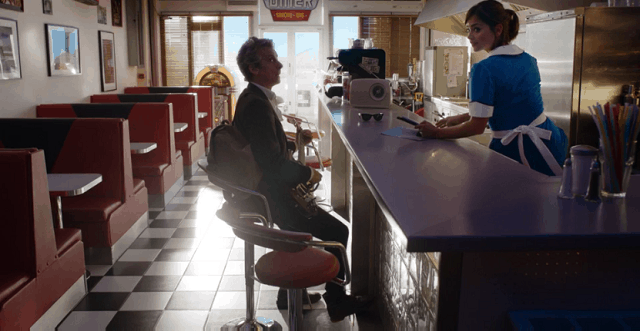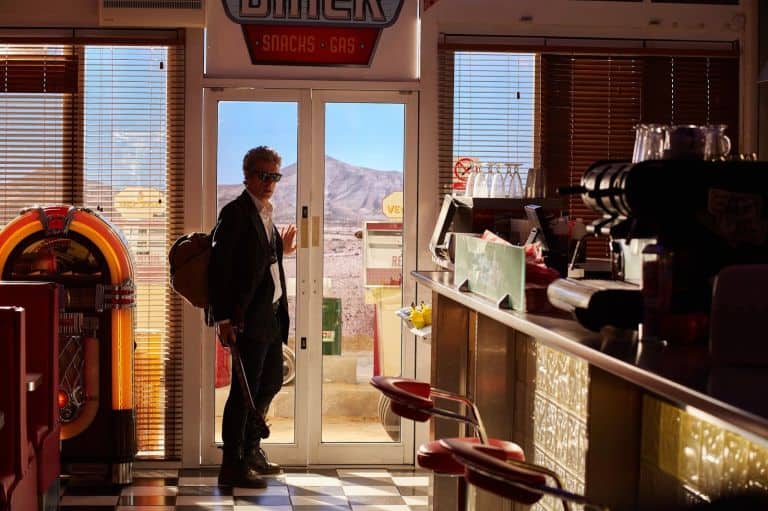Doctor Who, Series 9, Episode 10, “Face the Raven”
Written by Sarah Dollard
Directed by Justin Molotnikov
Series 9, Episode 11–12, “Heaven Sent” and “Hell Bent”
Written by Steven Moffat
Directed by Rachel Talalay
The curtain closes on Doctor Who series nine with the show’s first three-parter since series three’s Master-centric finale, “Utopia”/“The Sound of Drums”/“Last of the Time Lords”, and while it’s not perfect, the extended finale is a fitting end to what has been one of NuWho’s most consistent seasons. The end of series three is not one of the better Who multi-part stories, starting strong before fizzling out spectacularly (let’s take a moment to remember The Tenth Doctor shriveling into GollumDoctor before becoming floating JesusDoctor. Now to piggy back off of The Twelfth Doctor’s memory wipe…), and perhaps that’s why showrunner Steven Moffat wisely avoids a traditional multi-part structure with these episodes. Rather than telling a single longer narrative, as the rest of series nine’s multi-part stories have, writers Sarah Dollard and Moffat keep each of these episodes distinct, with plot and thematic ties connecting them, but little else. Each entry is given its own visual language and tone, and this keeps the audience from tiring of one setting, mystery, or adventure.
First up is “Face the Raven”, which brings back Joivan Wade’s Rigsy from “Flatline” and Maisie Williams’ Ashildr/Me and introduces a new corner of London where aliens live together peacefully, and in secret. This stylized addition to Who’s London is a promising idea that is explored somewhat, but still holds a lot of unrealized potential. The meat of the episode comes at the end though, when circumstances conspire to doom Clara, giving Jenna Coleman and Peter Capaldi strong material to work with as Clara says goodbye to The Doctor and bravely faces her death. This directly prompts “Heaven Sent”, as The Doctor is teleported into his Confession Dial and tortured for information while he attempts to process his grief at losing Clara. Eventually—approximately 4.5 billion years later—The Doctor emerges on Gallifrey, manipulating the Time Lords in “Hell Bent” to pluck a time-stopped Clara from her timeline before heading to the end of the universe, once again, to continue his desperate and dangerous ploy to keep her alive (or at least not dead yet). “Face the Raven” is a good, old-fashioned ticking-clock mystery, “Heaven Sent” is a bottle episode that leaves The Doctor alone with his thoughts, and “Hell Bent” is an energetic, continuity-filled puzzle box, paying off season-long threads of The Hybrid, The Doctor’s Confession Dial, and the question of how far The Doctor will go to save Clara.

Unfortunately, given how “Face the Raven” plays Clara’s death, saving it for the final minutes and not allowing the audience to fully grieve her loss, the return of Clara is a foregone conclusion, making her resurfacing in “Hell Bent” not nearly the thrill it could have been. While it is critically adored and beloved by many fans, I struggled with “Heaven Sent” for the simple reason that I didn’t believe the series when it insisted Clara was dead and staying that way. The episode’s examination of grief is laudable, as is Moffat and director Rachel Talalay’s trust in Capaldi to hold the episode on his own. Without the emotional core intended to drive the action, however, the installment’s cheated corners and convenient hand-waving of elements essential to the plot bog down this creative and ambitious episode. Thankfully, while “Hell Bent” is not as structurally interesting as its immediate predecessor, it remembers to include that most important of Who traits: it’s fun.
 After only a week off, it’s nice to see The Doctor and Clara back together, scheming and understanding each other as no one else can. It’s also very satisfying to finally have a Doctor and Companion agree that it’s time they part, rather than the Companion being traumatically torn from The Doctor or leaving him behind. It’s neat to see so many pieces of Gallifrey and for ClassicWho fans, the centrality of the Matrix to the proceedings strikes a particularly strong chord. “Hell Bent” is definitely over-long, with a solid half-hour of the episode, its flirtation with Western film tropes and clear inspiration from Star Wars unnecessary to the larger action, but it embraces these visuals with such style that it’s hard to hold them against it. From the dusty orange of Gallifrey to the return of the diner from “The Impossible Astronaut”/“Day of the Moon” to the gloom of the Cloister, the season’s final entry is filled with colorful, memorable spaces, each with their own feel and sense of history. That presence was lacking in “Heaven Sent” and felt far more stagey in “Face the Raven”, but at least directorial style has become a priority for the show.
After only a week off, it’s nice to see The Doctor and Clara back together, scheming and understanding each other as no one else can. It’s also very satisfying to finally have a Doctor and Companion agree that it’s time they part, rather than the Companion being traumatically torn from The Doctor or leaving him behind. It’s neat to see so many pieces of Gallifrey and for ClassicWho fans, the centrality of the Matrix to the proceedings strikes a particularly strong chord. “Hell Bent” is definitely over-long, with a solid half-hour of the episode, its flirtation with Western film tropes and clear inspiration from Star Wars unnecessary to the larger action, but it embraces these visuals with such style that it’s hard to hold them against it. From the dusty orange of Gallifrey to the return of the diner from “The Impossible Astronaut”/“Day of the Moon” to the gloom of the Cloister, the season’s final entry is filled with colorful, memorable spaces, each with their own feel and sense of history. That presence was lacking in “Heaven Sent” and felt far more stagey in “Face the Raven”, but at least directorial style has become a priority for the show.
More than anything, however, it’s the character touches and performances that move series nine into best-of consideration. Capaldi relaxed into The Twelfth Doctor this season, making him more casual, a good look for this iteration of the character. His self-reflection in “The Girl Who Died” and “Heaven Sent” was very welcome and his emotional connection to the electric guitar, introduced as a kickass moment in the season’s first story but brought back in the finale as a poignant send-off for Clara from a lost and sad Doctor, says more about the character than any of his tirades or grand speeches. Even just the return to the idea of The Doctor’s “duty of care” for Clara, something first mentioned by Clara in relation to her students, is a thoughtful, subtle example of how she’s shaped his thinking, Hopefully these changes will stick now that The Doctor is back to traveling on his own,
 As for Clara, Coleman has shone when given the opportunity, as she is in both “Face the Raven” and “Hell Bent”, and after a wobbly start, the series finally managed to balance Clara this season, letting her Doctor-ish qualities come through for better and worse (and not just worse, as was frequently hinted at in earlier seasons). One of NuWho’s more flawed Companions, Clara stays relatably fallible right up to the end of the season, heading off for one more adventure with Ashildr before returning to Gallifrey, indulging her reckless side while the Universe fractures around her. She’s also given ample opportunity to be brave, selfless, and charming, and it’s easy to imagine Clara, Ashildr, and Captain Jack gallivanting around the Universe together for a while, three undying adventurers out for a last laugh before Clara returns to her final heartbeat. The plot device introduced as a puzzle to be solved is now a fully explored, vibrantly dimensional woman. It may have taken Moffat a while to get there, but credit where it’s due: he and the other writers, and Coleman of course, have done excellent work with Clara over the past two seasons and while it’s definitely time, it’s still a little sad to see her go.
As for Clara, Coleman has shone when given the opportunity, as she is in both “Face the Raven” and “Hell Bent”, and after a wobbly start, the series finally managed to balance Clara this season, letting her Doctor-ish qualities come through for better and worse (and not just worse, as was frequently hinted at in earlier seasons). One of NuWho’s more flawed Companions, Clara stays relatably fallible right up to the end of the season, heading off for one more adventure with Ashildr before returning to Gallifrey, indulging her reckless side while the Universe fractures around her. She’s also given ample opportunity to be brave, selfless, and charming, and it’s easy to imagine Clara, Ashildr, and Captain Jack gallivanting around the Universe together for a while, three undying adventurers out for a last laugh before Clara returns to her final heartbeat. The plot device introduced as a puzzle to be solved is now a fully explored, vibrantly dimensional woman. It may have taken Moffat a while to get there, but credit where it’s due: he and the other writers, and Coleman of course, have done excellent work with Clara over the past two seasons and while it’s definitely time, it’s still a little sad to see her go.
With the departure of Clara and the promise of a re-commitment on The Doctor’s part to his core principles, fulfilling Clara’s last request to him, the stage is set for a fresh start in the upcoming Christmas special and subsequent tenth series. Whether this anniversary season brings returning friends and foes or all new challenges—for what it’s worth, the tenth season of Classic Who featured the first multi-Doctor story—Moffat and the rest of the team at Doctor Who have done good work this year, revitalizing a stagnant show, and I’m happy to be excited for what they come up with next.

